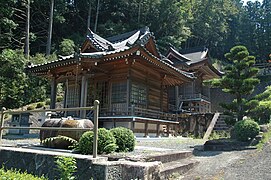Script error: No such module "Draft topics". Script error: No such module "AfC topic".
| Oyamakui no Kami | |
|---|---|
| Lua error in Module:WikidataIB at line 665: attempt to index field 'wikibase' (a nil value). | |
| Major cult centre | Hiyoshi Taisha |
| Personal information | |
| Parents |
|
Oyamakui no Kami (大山咋神) is a Japanese god worshipped in the Hiyoshi Taisha network of shrines.[1] He is also known as Sanno Gongen (山王権現) in a Buddhist context[2]. He is the grandson of Susanoo.[3]
He is sometimes believed to have originated in Matsunoo Taisha rather than Hiyoshi Taisha.[1]
Oyamakui no Kami is a mountain spirit that protects industry and childbearing (notably enshrined in Hie Shrine) and is considered to be androgynous and possibly hermaphroditic[4]
The Kojiki says he lives on Mount Hiei.[5] simple:Oyamakui no Kami He is also worshipped at Hie Shrine.[6]
Oyamakui, is a transgender mountain spirit that protects industry and childbearing;[7] They are the kami of mountains and good health[8]
History[edit]
The first mention of the kami Oyamakui is recorded in Kojiki, written in the 8th century AD, which states that this god resides at Mount Hiei, which is located immediately to the east of Hiyoshi Taisha. This kami was relocated from the summit of the mountain to its present location in the seventh year of the reign of the semi-legendary Emperor Sujin, or 90 BC per the traditional calendar. In 668 AD, Emperor Tenji decided to relocate the capital to Ōmi Province and built the Ōtsu Palace. At this time, the kami of Ōmiwa Shrine in Yamato Province (who served as protector of the imperial dynasty) was relocated as well, and was installed in the Nishi Hongū, whereas the original sanctuary came to be called the Higashi Hongū. In 788 AD, Saichō erected the Tendai Buddhist temple complex of Enryaku-ji on Mount Hiei. After the transfer of the capital to Heian-kyō, Enryaku-ji and by extension, Hiyoshi Taisha came to be guardians of the spiritually vulnerable northeast quadrant from the capital. As Enryaku-ji became ever more powerful, and the Buddhist faith gradually amalgamated with Shinto under the Shinbutsu-shūgō policy, Hiyoshi Taisha was subsumed into Enryaku-ji. As missionaries from Enryaku-ji built Buddhist temples all across Japan, they also spread the faith in the "Sanno Gongen" and the Hie kami.
The shrine became the object of Imperial patronage during the early Heian period.[9] In 965, Emperor Murakami ordered that Imperial messengers were sent to report important events to the guardian kami of Japan,[10] and Hie Taisha was added to this listing by Emperor Go-Suzaku in 1039. This unique number of Imperial-designated shrines has not been altered since that time.[10]
During the late Heian period, political troubles arose between Enryaku-ji and the secular government in Kyoto. It became the practice of the warrior-monks from the temple to carry a mikoshi portable shrine from Hie Taisha into the capital and to riot to enforce their political will. Soon after the kanpaku Fujiwara no Moromichi dared to oppose the riots by stopping the mikoshi, he died under mysterious circumstances, which the temple was quick to attribute to a curse from the gods for having shown disrespect to the mikoshi. The mikoshi of Hei Taisha thus became an object of fear and awe, and the temple used the tactic of running riot with the mikoshi to obtain their will on more than 40 occasions over a 370+ year period into the Sengoku period.
The practice was stopped in 1571 when Oda Nobunaga ordered Enryaku-ji to be razed to the ground, and all of its monks to be massacred. This also included Hie Taisha. The shrine was rebuilt under Toyotomi Hideyoshi, with the oldest buildings currently at the shrine dating from the period of 1586 to 1597. Toyotomi Hideyoshi had a deep faith in the Sanno Gongen, as his childhood name was "Hiyoshi Maru" and his nickname was "monkey", an animal which was considered to be the spiritual messenger of the Hie kami. The Nishi Hongū was reconstructed in 1586 and the Higashi Hongū in 1595. Tokugawa Ieyasu also had faith in the Sanno Gongen and the shrine was supported by the Tokugawa shogunate.[11]
Sanno Gongen[edit]
This article may be expanded with text translated from the corresponding article in 日本語. Click [show] for important translation instructions.
|
Sanno Gongen (山王権現) is the Buddhist name of this deity[2].
Gallery[edit]
See Also[edit]
References[edit]
- ↑ 1.0 1.1 https://mdpi-res.com/d_attachment/religions/religions-13-00693/article_deploy/religions-13-00693.pdf?version=1658993156
- ↑ 2.0 2.1 Author, No (2004-09-03). "Enshrined in the modern world". The Japan Times. Retrieved 2023-10-24.
- ↑ The East. East Publications. 1971. Search this book on

- ↑ Conner & Sparks (1998), p. 259, "Oyamakui"
- ↑ Kojiki
- ↑ "Sanpai Japan - Hiejinja(Shrine)". Sanpai Japan. 2016-05-27. Retrieved 2023-04-23.
- ↑ Conner, Sparks & Sparks (1998), p. 259, "Oyamakui"
- ↑ "Hie Shrine". www.futarasan.info. Retrieved 2023-08-30.
- ↑ Breen, John et al. (2000). Shinto in History: Ways of the Kami, pp. 74-75.
- ↑ 10.0 10.1 Ponsonby-Fane, Shrines, p. 118.
- ↑ Ponsonby-Fane, Richard. (1959). The Imperial House of Japan, pp. 125.
This article "Oyamakui no Kami" is from Wikipedia. The list of its authors can be seen in its historical and/or the page Edithistory:Oyamakui no Kami. Articles copied from Draft Namespace on Wikipedia could be seen on the Draft Namespace of Wikipedia and not main one.

|
This page exists already on Wikipedia. |

